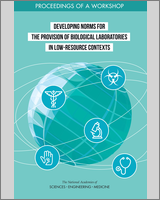NCBI Bookshelf. A service of the National Library of Medicine, National Institutes of Health.
National Academies of Sciences, Engineering, and Medicine; Division on Earth and Life Studies; Board on Life Sciences; Policy and Global Affairs; Lowenthal MD, Sharples FE, editors. Developing Norms for the Provision of Biological Laboratories in Low-Resource Contexts: Proceedings of a Workshop. Washington (DC): National Academies Press (US); 2019 May 1.

Developing Norms for the Provision of Biological Laboratories in Low-Resource Contexts: Proceedings of a Workshop.
Show detailsA Workshop on Developing Norms for the Provision of Laboratories in Low-Resource Contexts
DAY ONE: Wednesday, 27 June 2018
| 9:00 AM | Welcome and Goals of the Meeting
|
| 9:10 | Overview of the 2011 Istanbul Workshop, Biosecurity Challenges of the Global Expansion of High-Containment Biological Laboratories
|
| 9:25 | Session 1: What Are Donors Trying to Accomplish?
|
An Introduction to the Current Picture for High Containment Labs
| 10:15 | Session 2: The Need for Containment Laboratories: An Overview
|
| Discussion | |
| 10:45 | BREAK |
| 11:15 | Session 3: The Current Picture for Biological Labs—Estimate of Numbers in Low-Resource Countries: Are They Functioning as Planned?
|
| 11:25 | Session 4: Who Is Funding What Where? A Discussion of Building a Map of Projects
|
| 12:30 PM | BREAK FOR LUNCH |
| 12:45 | Luncheon Speaker: Existing International Standards and Codes
|
Digging Deeper into What Factors Determine Success
| 1:45 | Session 5: Key Factors for Building and Sustainably Operating High Containment Labs in Low-Resource Contexts: An Overview
|
| 2:00 | BREAKOUT Session 1: Group Discussion of Factors to Consider When Deciding What Biological Laboratory Capabilities a Low-Resource Country Requires
|
| 3:30 | BREAK |
| 4:00 | BREAKOUT Session 1 continued |
| 5:00 | Report from Chairs of the Breakout Session Groups, Preview of Topics to Be Addressed in Day 2 |
| 5:30 | Adjourn Sessions |
| 6:00 | Reception Discussions of the Workshop and Needs for Day 2 |
| 7:30 | Adjourn for the day |
DAY TWO: Thursday, 28 June 2018
| 9:00 AM | Alternatives to Culture Work in loco: Models of Successful Provision of Lower-Containment Laboratory Capacity That Meet Diagnostic and Research Needs
|
| 10:30 | BREAK |
| 11:00 | Developing a Candidate Set of Norms |
| Instructions to breakout groups, and sharing of documents on existing guidance and suggestions in development | |
| BREAKOUT Session 2: Key Dilemmas and Options, Merits, and Downsides to Address Them. Use results to Begin to Develop Candidate Set of Guiding Principles and Common Norms. | |
| Session Chairs: Ann Arvin, David Franz | |
| 12:30 PM | LUNCH DISCUSSIONS of Morning Session and Goals for Afternoon |
| 1:30 | Resume Breakout Session 2: Continuation, Revision of Candidate Norms |
| 3:00 | BREAK |
| 3:30 | Report from Chairs of the Breakout Session Groups Discussion of Group Candidate Norms, Next Steps |
| 5:00 | ADJOURN WORKSHOP |
- WORKSHOP AGENDA - Developing Norms for the Provision of Biological Laboratories ...WORKSHOP AGENDA - Developing Norms for the Provision of Biological Laboratories in Low-Resource Contexts
Your browsing activity is empty.
Activity recording is turned off.
See more...